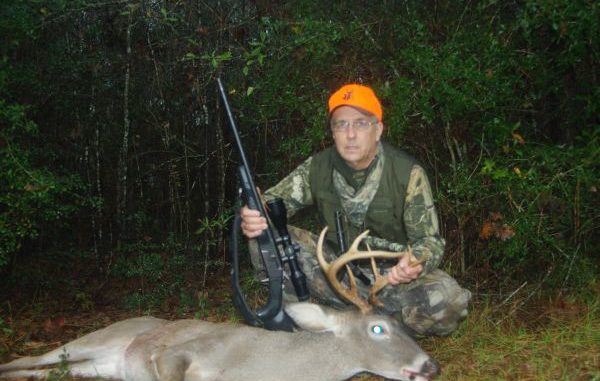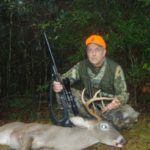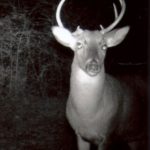
The deer season is over, and it is now time to measure the antlers and recognize the trophy-class bucks, along with looking at the deer harvest data and determining what has been accomplished with your deer management program.
‘Do the math’ is a popular term used these days when talking about economics and the value of something. While you might not realize it, math is an important part of wildlife management, especially concerning white-tailed deer. A lot of money is being spent these days on deer management work, and unless someone who has lots of money to spend on whatever (another overused term these days), it would behoove you to look at the data and see if the money is being put to good use and is producing positive results.
Most deer clubs and landowners are interested in producing quality deer and determining the Boone & Crockett score of a buck is one way to judge your program. A buck scoring 130 inches is certainly a quality buck and will qualify a hunter for recognition on the Annual Louisiana Big Buck List. Copies of these score sheets and the method for scoring a deer are available at several Web sites.
Of course you can bring your buck to the Louisiana Sportsman Show and Festival on March 15-16 in Gonzales and have it officially scored, or to the Big Buck Contest at Bowie Outfitters in April.
If you are producing and harvesting bucks that score 130 or better, then you are doing something right with your program and you should continue with the good work. However, if your program is producing adult bucks that are 4 ½ years or older and scoring less than 120, you probably need to take a close look at the data and see what is going on. It could be habitat issues or it could be herd issues (too many deer) — or a combination of both — or it might be that your habitat is producing the best buck that it can and you just need to be content with what it produces.
When the Department of Wildlife & Fisheries looks at harvest data, they look at the big picture, the statistics for the state as a whole, and then they break it down into parishes and into habitat types. The data averages for the state will utilize the data from all parishes and habitats, both good and bad, to produce the state averages.
If you are only harvesting a few deer, this may be a good place to start and compare what is going on with your land to the state as a whole. If your averages for the live weight, number of antlered points, circumference of beam bases, length of main beams, the inside spread, percent of 1 ½-year-old spikes, live weights of does and lactation of adult does for the various age classes is in line with or better than the state averages, your program is probably working OK.
If the data is below the state averages, you might want to look at the averages for the parish or for the habitat type. The statistics for bucks killed on bottomland hardwood habitat are much different from deer killed on dominant piney woods habitat.
Of course, in order to do the math there needs to be harvest data that was collected from the deer killed during the season, and if you do not have that, then you have no idea what your program is doing.
You could look at some simple calculations that might give you an idea of what is going on with your program. If your deer kill was one deer per 100 acres, your harvest is in line with the state average. You might also want to look at the number of deer seen or killed per hunting effort. On the state wildlife management areas, a deer killed for every eight hunter efforts is considered good.
This past November, I hunted 15 days and killed one deer — a deer kill per 15 hunter efforts. In December, I hunted 14 days and killed one deer — a deer per 14 hunter efforts. Now keep in mind I am in an area with good deer numbers and am selectively harvesting the deer I see.
A better way of looking at this data would be to examine how many deer I see per hour of hunting. In October, I observed a deer for every two hours of hunting, and in November I observed a deer for every 2 ½ hours of hunting, and in December it shot up to one deer seen per every six hours of hunting. The rut in our area is in December, and one would think that the deer sightings would go up —but as I mentioned last month, this was an unusually warm winter and when the temperatures rises, deer movement declines.
I have no doubt that this unusually warm winter that gave us daily temperatures above normal is the main reason for the low deer harvest across the state this year. My sightings per hour in January actually improved and went to one deer for every four hours of hunting, but again when considering I am hunting an area with very good deer numbers, it is not real good.
But deer are not going to move in their winter coats when the temperature is above 60 degrees; they wait until night to do their activity. It would appear that I am not getting my money’s worth regarding the time I spend hunting, but I am not going to whine about the lack of deer. The cameras show we have plenty of deer — there are just too many other factors at work against me, and when Mother Nature hands you a January day with a temperature of 75 degrees, not too much can be done about that.
In December, I harvested a 4 ½-year-old buck in Clinton that weighed 125 pounds. It was an 8-point but had broken a brow tine, had 17-inch main beams, 3 3/8-inch bases and an inside spread of 13 inches. The state averages for 4 ½-year-old bucks are 185 pounds, 8 points, 19-inch main beams, 4.3-inch bases and 16-inch inside spread.
The buck I killed was well below the average for 4 ½-year-old bucks. My buck had been sick with the bluetongue virus, which explains the low body weight. But bluetongue would not have impacted the antlers.
The physical data for a 4 ½-year-old buck in the southeast piney woods are 166 pounds, 8 points, 19-inch beams, 4.4-inch bases and 16-inch inside spread. The buck I killed was well below the state averages for this age class, and well below the averages for southeast piney woods. Our harvest data as a whole reflects poor growth and development for our deer, and indicates the money we are spending is not doing much to impact the physical condition of the deer.
On this small tract of land, we are at the mercy of the adjacent landowners, and these landowners are not doing much timber cutting. The nutritional plane of this habitat is low and is not going to improve until some major timber cutting is done. We logged 30 acres of this small tract, cut all the pine and left the hardwoods. This will have some impact in the upcoming years, but until other landowners contribute, deer growth and development will remain poor.
We do both winter and summer plantings, but a few acres of forage is not going to have much of an impact. We might see some benefit to a few individual animals, but as a whole we will just continue to shoot deer in all age classes and in particular harvest those that are low-end deer in an age class.
Our problem probably represents a major problem for the state as a whole. Until the landscape changes through increased logging, especially in the pine-dominated timber regions, deer herds will remain suppressed.
The intensive pine management on the industrial forest lands has just about made them unproductive for deer. In some of the lower regions of Southeast Louisiana, the hurricanes have hammered both the habitat and the herds.
The LDWF is making changes in the proposed hunting seasons for 2014 in some areas across the state. A new Area 4 is being created in Southeast Louisiana, along with changes for Area 6. Hunting opportunity is being reduced by the return of doe days.
The idea is to reduce the harvest and increase the herds in these areas. In the Florida Parish region, which is to become the new Area 4, I am not sure this is good. Trying to stockpile deer on poor-quality habitat results in lots of low-end deer, somewhat like the situation we have in the area I hunt.
However, I have confidence in the LDWF biologists and know they will be on top of the situation and will be working hard to keep the deer herds in this state productive and healthy.
So do the math and see what is going on in your deer herd. If it doesn’t look too good, you may want to contact LDWF and ask them for some assistance.




